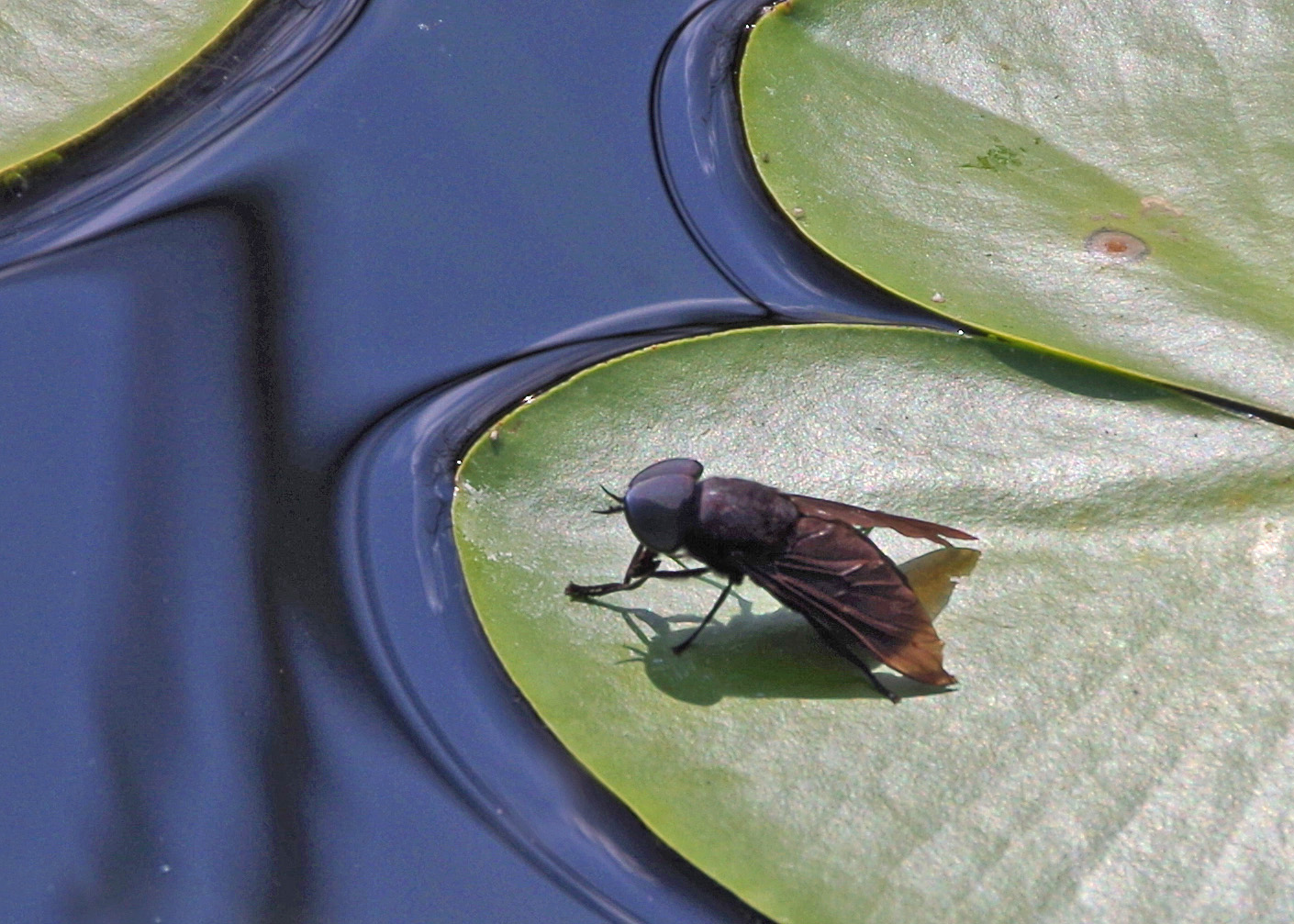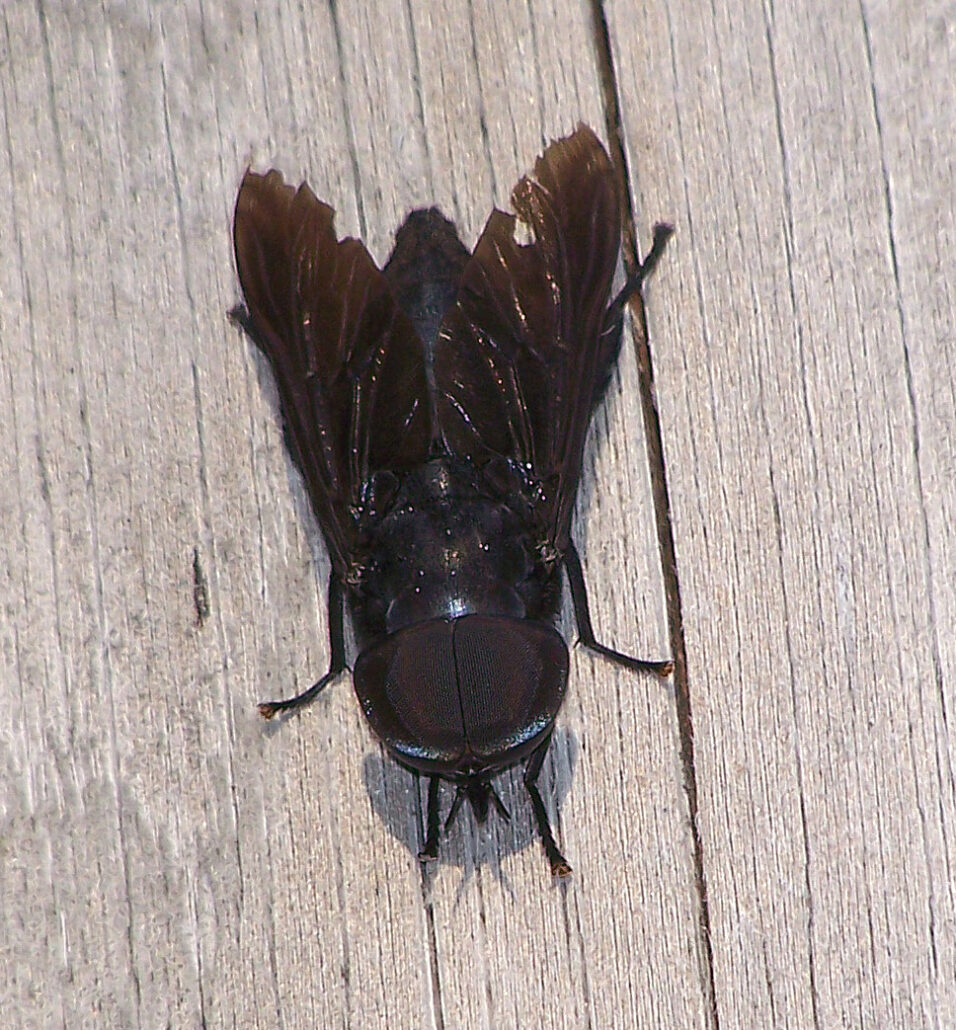
by Kate Redmond
Black Horse Fly redo
Howdy, BugFans,
The BugLady has gotten a few reports of these magnificent flies recently, so here’s an episode from 2018, with some new words and thoughts and links added.
People often ask the BugLady what her favorite bug is, and although there’s a crowded field for second place, the Tiger Swallowtail butterfly is the hands-down winner. Most Impressive Bug? The Black horse fly (Tabanus atratus) (family Tabanidae) certainly ranks high on that list. It is one, imposing horsefly, and although she knows that it’s (probably) not going to pursue her (they generally stalk non-human mammals), just seeing one gives her a bit of a start. We visited the Black horse fly in the distant past, very briefly, one of an array of flies, and it’s time to fill in some gaps in its biography. This fly is not the tiny, humpbacked Black fly that lives near rivers and torments all comers https://uwm.edu/field-station/bug-of-the-week/black-fly-the-bug-the-legend/.
Yes, there are larger flies in the neighborhood – some of the robber flies, for example, are longer – but they lack the heft of this fly. Even the official measurement of 20 to 28 mm (an inch-ish) doesn’t adequately communicate it. As one bugguide.net correspondent put it: “This is the largest fly I have ever seen, I actually saw two of these at two different locations on the same day. I am guessing it is a horsefly of some sort. A handful of these things ought to be able to carry a horse as a ‘to-go’ meal!” And as another bugguide.net correspondent said, “I’m assuming this is a female Tabanus atratus? First time I’ve seen one. Not sure I want to see another.” And as Jess Adams wrote in his blog “Long Leggedy Beasties,” “I’m not sure if they are called horse flies because they feed on horses or because they are the size of horses….”
Indeed, it’s hard to believe that these huge flies (https://bugguide.net/node/view/1114670/bgimage) are not the biggest horseflies on the continent, but they come in a close second to the American horsefly https://bugguide.net/node/view/117708/bgimage, which may hold the World Title.

“Atratus” means “clothed in black,” and one of the common names for this fly is the Mourning fly. Adults are variously dark gray/black/brownish-purple, with equally dark wings, dark eyes, and antennae that are hooked https://bugguide.net/node/view/1890081/bgimage (in case you still were unsure of your ID). Males have wrap-around (holoptic) eyes that touch at the top of the head https://bugguide.net/node/view/1494235/bgimage, and females’ eyes are separated (dichoptic) https://bugguide.net/node/view/827314/bgimage.
It’s been suggested that they’re the infamous “blue-tailed fly” from the folk song “Jimmy Crack Corn” https://bugguide.net/node/view/367846/bgimage (the BugLady expected to find a bunch of common names for this fly, most of them profane, but she didn’t come across any). They can be a challenge to photograph because their velvety, black color sucks up the light. Check the phenomenal, final three pictures on the Maryland Biodiversity website https://www.marylandbiodiversity.com/view/9571.
Their larvae are pale with dark bands https://bugguide.net/node/view/677968 and may be twice as long as their elders when mature. They have pointy mouthparts that, like their elders’, can pack quite a punch.
Though it’s been recorded throughout the Lower 48, the Black horse fly is mostly found east of the Rockies. Its larvae live in wet/damp places at the edges of wetlands, and the adults are generally found within a mile or so of the ponds they grew up in.
Females lay their eggs in mounds on wet ground or on sedges and other vegetation above water, and they may deposit three or four such masses https://bugguide.net/node/view/1014993/bgimage (male Black horse flies don’t live for long). The newly-hatched larvae drop down and dig into the detritus or mud, and they spend two years as larvae.
According to Werner Marchand in the Monographs of the Rockefeller Institute for Medical Research (1920), “Walsh found his aquatic larvae, on many occasions, ‘amongst floating ‘rejectamenta.’ On one occasion, he found six or seven specimens in the interior of a floating log so soft and rotten that it could be cut like cheese.” He goes on to say that “when handled, the larva is, according to Walsh, ‘very vigorous and restless,’ and burrows with great strength between the fingers, and even on a smooth table, walks as fast as any ordinary caterpillar, backwards or forward; when placed in a vessel of water it swims vigorously, twice the length of its body at every stroke...”
“Rejectamenta” – the BugLady’s new favorite word!
Marchand writes that the larvae can produce sound “…the crackling noise was freely produced by full-grown Tabanus atrata larvae, and … was chiefly heard when the larvae were disturbed and defending themselves with their sharp mandibles. The coincidence of the two phenomena was so close that I am bound to assume that the sound was produced by means of the mandibles.”
The larvae climb up onto drier ground to pupate in the soil. Marchand says that “the pupa state lasts but a few days, and before the emergence of the fly the pupa is pushed to the surface of the ground by means of the bristles and thorns of the abdomen, with bending movements of the body.” For more about what happens in a pupal case, see http://uwm.edu/field-station/pupal-cases/.
Much of what is written about Black horse flies concerns their food and feeding habits. The larvae are active predators. Marchand again: “On September 2, 1863, he found a nearly full-grown larva among floating rejectamenta, and between that date and September 23, this larva devoured ‘the mollusks of eleven univalves’ (genus Planorbus) from one-half to three-fourths of an inch in diameter; and on three separate occasions observed it work its way into the mouth of the shell.” They eat other aquatic invertebrates, too, and small vertebrates, and even their Tabanid brethren. Jones and Anthony, in The Tabanidae (Diptera) of Florida write “medium to large-size larvae of Tabanus atrata are extremely aggressive. When two or more are placed in the same container, only a short time usually elapses before all are dead except one. The survivor will feed on the victim if hungry, but generally it appears that a larva kills to avoid being killed.”
Like mosquitoes, female tabanids need a blood meal in order to maximize egg production. Both males and females feed on nectar from flowers (he lacks her piercing mouthparts), but when she is in reproductive mode, a female will stalk livestock and other large, dark mammals by their movement and by their CO2 trail. She punctures her victim’s skin with a pretty sophisticated set of blades (modified mandibles and maxillae) and is classed as a sanguivore – more specifically, she is a telmophage, because she laps up the resulting pool of blood instead of sucking it (unlike mosquitoes, who are “vessel feeders” or solenophages that employ a “syringe and pump”). Got it?
Although humans are generally not targets, a bite is, apparently, unforgettable. When present in numbers, these flies can be a problem for livestock due to blood loss, distress, and potential disease transmission.
Several resources pointed out something that the BugLady had never really thought about before – that being a sanguivore, getting a meal by puncturing an animal that is larger and that takes exception to being punctured, is a dangerous way to make a living. The blood is, as one researcher points out, “not freely given,” and a potential victim may simply swat its tormentor away or may eat it. The BugLady once went on a canoe trip on Wisconsin’s Oconto River during which she was accompanied by clouds of deer flies and learned to swat them without breaking stroke, and after nine hours on the water, there was a layer of dead deer flies over the bottom of the canoe (our blood was not freely given, either) (the 50 yards of whitewater just before the pull-out spot were pretty memorable, too).
Another down-side of blood-feeding is that depending on the body temperature of the “pierce-ee,” the cold-blooded piercer is courting temperature shock by ingesting a substance that is much warmer than it is.
The “take-home” is that sanguivores need to do their work in a hurry (solenophages tend to get in and out more quickly and quietly than telmophages), and that the nutrition received needs to be worth the energy – and risk – required to extract it.
Kate Redmond, The BugLady
Bug of the Week archives:
http://uwm.edu/field-station/category/bug-of-the-week/
